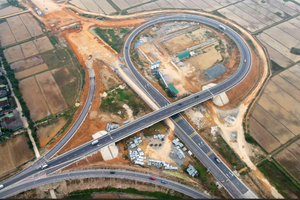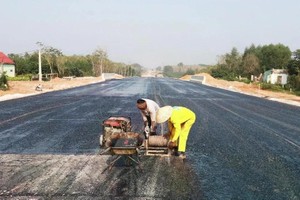Boasting biodiversity
 |
Ninh Thuan secures sustainable future through biodiversity. (Photo: VNA) |
Ninh Thuan province is blessed by nature with various landscapes and ecosystems. Home to over 147,419 hectares of natural forest and more than 10,666 of planted forest, Ninh Thuan has a forest coverage rate of 47.11 percent.
Its Nui Chua World Biosphere Reserve and Phuoc Binh National Park boast rich and diverse ecosystems, with excellent natural landscapes and rare animals and plants which have been given a priority for preservation.
According to Director of the Management Board of the Nui Chua National Park, the Nui Chua World Biosphere Reserve covers 106,646 hectares with the core area spanning 15,752 hectares.
The Nui Chua National Park has extremely rich and diverse biological resources, in which the dry forest ecosystem is considered the standard model, the most unique of Vietnam as well as Southeast Asia. The national park consists of three natural areas of forest, sea and semi-desert.
According to the latest survey, 1,516 plant species were found in the national park, including 27 that are endemic to the area, and 54 that are recorded in the Vietnam Red Book and the International Union for Conservation of Nature (IUCN)’s Red List.
It also has rich fauna with 763 species of wild animals, 60 of which are rare, 48 on the brink of extinction according to the Vietnam Red Book, and 34 threatened with extinction globally. Boasting 40 kilometers of coastal line and 7,352 hectares of marine protected area, Nui Chua coastal area is a rare place on the mainland where protected sea turtles come to lay eggs every year. Nui Chua is also home to the largest coral reef in the nation, with more than 350 species and hundreds of marine animals.
Deputy Director of the Management Board of the Phuoc Binh National Park Nguyen Ngoc Minh said that the national park, which spans some 25,000 hectares of land, has six major kinds of vegetation, and eight secondary plant species.
As one of the most diverse national parks in the country, Phuoc Binh is now home to 1,338 kinds of floral, 172 of which are listed as rare species in the Vietnam Red Book, and 58 in the IUCN’s Red List.
Additionally, the national park is providing the habitat for 347 species of fauna, 64 of which are named in the Vietnam Red Book and 50 in the IUCN’s Red List. Particularly, it is home to four species endemic to Indochina, namely yellow-cheeked gibbon, black-shanked douc, owston’s palm civet, and giant muntjac.
Seeing biodiversity significant to local socio-economic development, Ninh Thuan province has paid due attention to the planning work as well as biodiversity protection and development in the two national parks. It has made concerted efforts to protect natural forests, expand areas of planted forests, preserve endangered species, and build botanic gardens and marine life rescue areas for scientific research, environmental education and eco-tourism development.
However, the province is facing the risk of biodiversity degradation, with many species on the brink of extinction, and genetic diversity reduction.
Experts attributed the degradation to habitat loss which is caused by population pressure, forest destruction for cultivation, climate change, and environmental pollution, among others.
Protection enhanced
With a view to controlling the use of natural resources and reducing the negative impact on local biodiversity, the provincial People’s Committee ordered the Department of Natural Resources and Environment, the Department of Agriculture and Rural Development and competent agencies to evaluate local biodiversity, outline measures for sustainable use of natural resources and protection of forests and rare and threatened animals, while enhancing inspections to handle violations in a timely fashion.
According to Vice Chairman of the provincial People’s Committee Le Huyen, as part of efforts to carry out the national strategy on biodiversity by 2030 with a vision to 2050, the province is promoting the comprehensive implementation of management solutions, and enforcement of the law on biodiversity.
An array of biodiversity preservation projects and programs are being carried out, including forest handover to local residents for protection, forest regeneration, and habitat protection, he said, adding more than VND 112 billion (US$4.6 million) is splashed out on reforestation on an area of 1,121 hectares, including 500 hectares of special use forest and 621 hectares of protective forest, during 2023-2025.
This is a bold step to reforest bare land and hills, prevent erosion and desertification, ensure water security, and protect biodiversity across the province, he said.
Along with providing preferential loans for local people to develop livelihoods, the province has enhanced communications work to raise public awareness of forest and biodiversity protection.
Besides, the province is ramping up efforts to develop various kinds of eco-tourism such as sea tourism, forest tourism, scientific tourism, education tourism and resort tourism to lure more visitors, helping generating incomes for the biodiversity preservation work.
Tourism development in the province has followed the principles of low impacts to the surrounding landscapes, not causing adverse impacts on animals and plants, and environmental pollution, while ensuring the biodiversity of the two national parks.
























